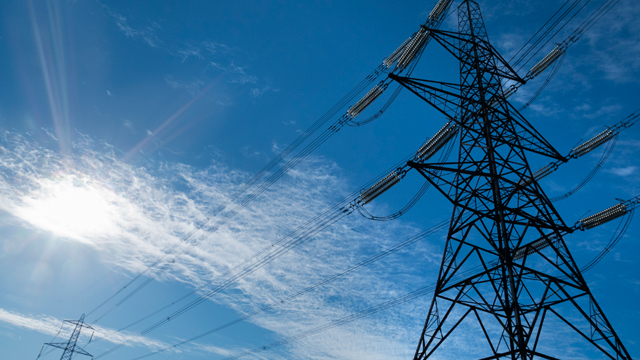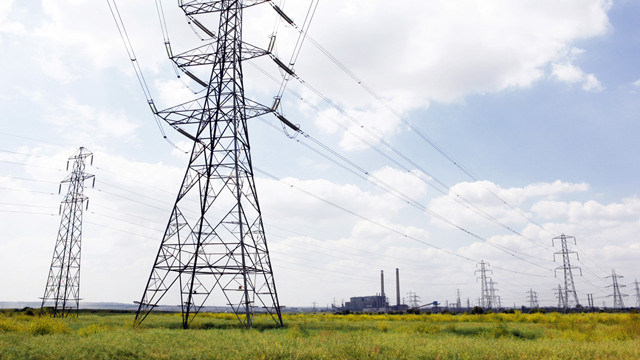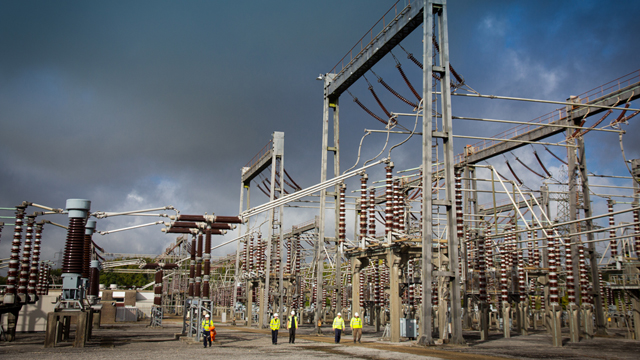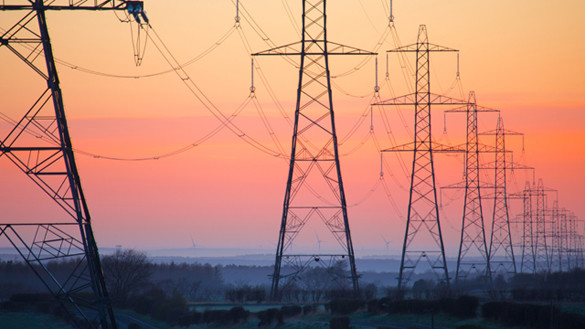
Everything you ever wanted to know about electricity pylons
Electricity pylons (also known as towers) have been part of the British landscape for almost 100 years, but how much do you really know about them? Here are 12 facts you might not know about these iconic steel structures.

1. There’s more to how electricity pylons work than meets the eye.
Pylons are used to support electrical cables that transmit high-voltage electricity from where it’s generated, such as a power station or wind farm, to where it can be distributed to our homes and businesses.
Electricity comes out of a power station at a low voltage, around 10-30 kilovolts (kV). It then passes through a ‘step-up’ transformer at a transmission substation to create high-voltage electricity – up to 400,000 volts – which travels around National Grid’s electricity transmission network. Increasing the voltage allows for greater efficiency with less energy loss. ‘Terminal’ towers are located at each end of the route, while tension or angle towers enable the route to be realigned if necessary.
Insulators made of porcelain or toughened glass support the overhead high-voltage cables and protect the steel towers from becoming live themselves.
Did you know? While people call them pylons in the UK, they’re more correctly called suspension, tension or transmission towers. To complicate things, in the US ‘pylons’ are traffic cones.
The voltage of the electricity in the transmission cables (lines) is too high for use in everyday appliances, so a ‘step-down’ transformer in a substation is used to lower the voltage.
Britain's distribution network operators connect the transmission network to where electricity is used, 'distributing' it a these lower, more usable voltages for our homes and businesses.
What's the difference between electricity transmission and distribution?
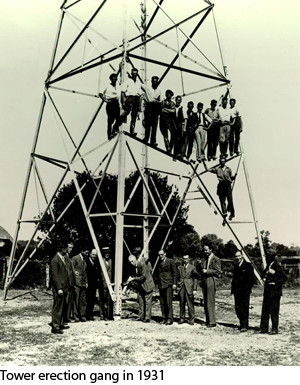
2. The word pylon comes from the Greek word 'pyle' for 'gateway'.
In Ancient Egypt, pylons were the impressive obelisk-shaped towers on either side of the doors to temples. Egyptology was all the rage in the Twenties, after the discovery of Tutankhamun’s tomb and the boy king mummy in 1922. And this was the decade when the first steel pylons were erected and they eventually became the gateways to electricity for everyone.
3. The design for pylons was the winning entry in a competition run by the Central Electricity Board in 1927.
Leading architect Sir Reginald Blomfield often gets the credit for the ‘lattice’ design, which was intended to be more delicate than the brutalist structures used in Europe and the United States. But the winning design, which still strides across our landscape today, was submitted to the competition by the Milliken Brothers, an engineering company based in the US, and chosen by Blomfield, designer of London’s Lambeth Bridge.
The basic latticed A-frame structure has remained the same for over 100 years, with adjustments for higher voltages requiring longer insulator strings and landscape requirements like lower heights near airfields or huge towers to cross rivers. (See no. 9 below for the world’s tallest pylons.)
4. The UK's first electricity pylon was built in Scotland in 1928.
It was erected on 14 July in Bonnyfield, near Falkirk. But the Central Electricity Board’s new transmission grid didn’t begin operating until 1933, when it was run as a series of regional grids. The grid became a truly national system in 1938, a whole 10 years after that first pylon was erected.
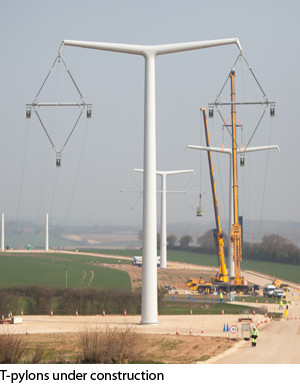
5. T-pylons, the first new design for UK pylons in nearly 100 years, are now operational.
This new shorter, sleeker pylon design was chosen from 250 entries in an international competition organised by National Grid, the UK Government and the Royal Institute of British Architects in 2011.
The winning T-shaped pylon comes from Danish firm Bystrup and measures 114ft (35 metres) tall. It’s about 50ft shorter than the traditional steel lattice structure but can still transmit 400,000 volts.
In 2023, 36 of the world's first T-pylons were energised between Bridgwater and Loxton in Somerset – a major milestone in National Grid's Hinkley Connection project to connect 6 million homes and businesses in the South West to home-grown, low-carbon energy. A further 80 T-pylons will be completed and energised by 2024.
6. There are almost 22,000 pylons on the transmission network in England and Wales.
The pylons connect over 4,500 miles of high-voltage overhead lines across the two countries – that's enough to stretch from London to Mumbai.
7. Pylons are tall because transporting electricity at high voltage requires high clearance for safety purposes.
Also, tall pylons mean the wires can easily straddle roads, rivers and railway lines. As a general rule of thumb, National Grid’s pylons are a minimum height of 118ft (36m).
As overhead lines are normally uninsulated, it’s important to make them as high as possible to ensure nothing gets too close to them. You should never climb or attempt to get near to overhead lines, as this has the potential to cause severe shocks, burns or even death.
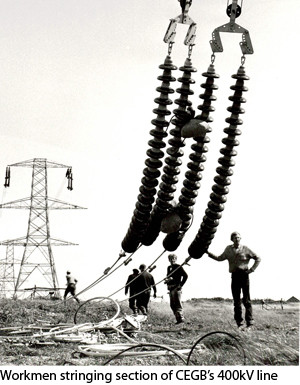
8. The tallest electricity pylons in the UK are on each side of the River Thames.
Built in 1965, the two towers are 623ft tall (190m) – taller than London's BT Tower – and positioned at Botany Marshes in Swanscombe, Kent and West Thurrock in Essex.
9. The world’s tallest pylon is four times the height of London’s Big Ben.
This giant, 1,246ft (380m) tall pylon in China carries high-voltage power cables between Jintang and Cezi islands in the eastern province of Zhejiang and was completed in 2019.
10. Why can birds sit on the power lines between pylons?
You may have wondered about this as you spot birds ranked along power lines without any seeming effect – why aren’t they electrocuted?
Birds don't get electrocuted on power lines because electricity does not move through their bodies. When the bird sits with both its feet on the electrical wire, its legs have an equal electrical potential, so the electricity will not move through its body. The bird isn’t touching the ground or anything in contact with the ground, so the electricity stays in the power line.
11. Pylons are being taken down in some areas of natural beauty, as electricity is moved through underground tunnels.
When the UK national electricity network expanded in the 1950s and 1960s to meet post-war demand, the priority was achieving nationwide electrification as quickly and cost-effectively as possible.
National Grid is working to erase the impact of pylons and overhead lines in some of the country’s most beautiful landscapes, by constructing electricity tunnels underground through the Visual Impact Provision Schemes. These schemes are chosen by independent stakeholders – including the National Trust, Campaign to Protect Rural England (CPRE) and the Ramblers Association – and are funded by the energy regulator Ofgem.
Working closely with local environmental organisations and councils to ensure minimal impact on the environment, pylons have been fully removed in and Peak East, the Snowdonia project has begun construction and the Cotswolds and North Wessex Downs schemes are in the planning stages.
12. Ever since their first construction, pylons’ size and number have divided opinion.
Writers Rudyard Kipling, author of The Jungle Book, and John Maynard Keynes wrote to The Times complaining of ‘the permanent disfigurement’ of our landscape. But a group of poets led by Stephen Spender were so inspired by the metal pylon march they called themselves The Pylon Poets.
It may sound like an entry in Have I Got News For You?, but today the website Pylon of the Month is a must-see for pylon lovers, as is the Pylon Appreciation Society.
Last updated: 28 Mar 2023
The information in this article is intended as a factual explainer and does not necessarily reflect National Grid's strategic direction or current business activities.
